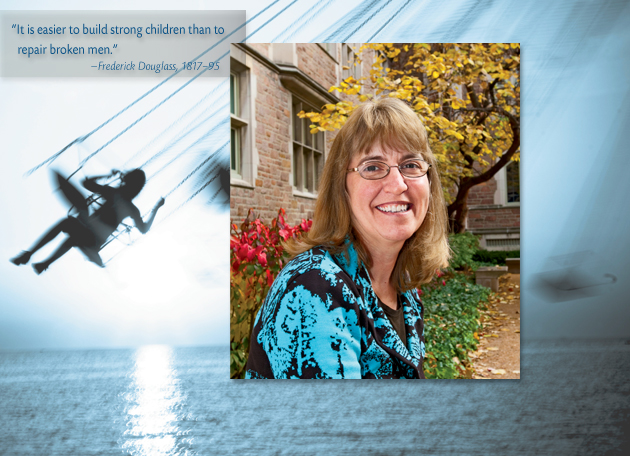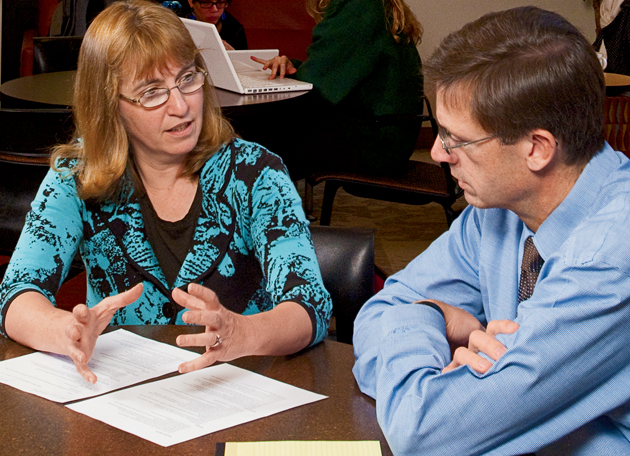
“It is easier to build strong children than to repair broken men.”
—Frederick Douglass, 1817–95
Innovative, down-to-earth, animated by what husband and colleague F. Brett Drake calls “a pure commitment to helping people lead better lives,” Melissa Jonson-Reid has taken on one of society’s most alarming quandaries: the abuse and neglect of 6 million children every year in the United States.
Jonson-Reid, PhD, professor of social work and founding director of the Center for Violence and Injury Prevention (CVIP) at the George Warren Brown School of Social Work, has additional grim statistics:
• Every day, approximately five children in the United States die from abuse and neglect. “At least half of those killed had been brought to the attention of the authorities,” Jonson-Reid says.
• The state of Missouri is one of the top five in the nation in deaths related to child abuse and neglect. According to the latest available figures — compiled before recent spending cuts — the per capita allocation for child welfare in Missouri was $70. States with funding starting at $158 per child had fewer deaths related to abuse and neglect.
• “While most low-income families do not maltreat their children, poverty is the most consistent risk factor associated with abuse and neglect,” Jonson-Reid says. An estimated 25 to 50 percent of abused or neglected children also endure violence from a parent’s intimate partner. Such children are at twice the risk of violent or nonviolent delinquency later on — compared to children in very low-income but safer homes.
• According to some of her very recent, unpublished research using agency data in Missouri, about 20 to 33 percent of young women who are poor and have been abused or neglected are pregnant before they are 18. These same young women appear to be at twice the risk of being accused of child mistreatment themselves when they reach adulthood.
“Child abuse and neglect exact a huge personal cost from the children involved as well as tremendous short- and long-term economic costs to society,” Jonson-Reid says. “Investing in preventing child maltreatment is both a moral and economic imperative.”
• “Child abuse and neglect exact a huge personal cost from the children involved as well as tremendous short- and long-term economic costs to society,” Jonson-Reid says. “Investing in preventing child maltreatment is both a moral and economic imperative.” In 2007, for example, estimated direct costs (such as hospitalization, agency services and law enforcement) added to long-term costs to society (among them mental-health care, adult criminal justice and lost productivity) totaled almost $1.5 billion in Missouri alone. (The figures were derived from estimates based on national costs adjusted for the numbers of Missouri children in both officially substantiated cases as well as so-called unsubstantiated cases — because of system procedures — of children who do need services.)
The situation is entrenched, controversial and almost unimaginably complicated, which only reinforces Jonson-Reid’s determination. “Our society must evolve to the point where a firm priority is that our children must not live in poverty and not grow up in violent or neglectful families,” she says. Until then, “there are ways to apply our research in the real world. We need to intervene with children who have had these insults to their development, find ways to prevent abuse and neglect, and make our policies and programs much more effective.”
Finding solutions that work
Jonson-Reid’s research agenda has always been ambitious. To make a difference, she and frequent research partner Brett Drake, PhD, professor of social work and a respected investigator in his own right, study children’s lives over years in environments often laced with other forms of family cruelty, community violence, delinquency and crime. While poverty is key, other difficult social factors apply. These factors include substance abuse, mental-health problems, intimate partners’ violence to parents and children, earlier trauma to caregivers, inappropriate expectations of children, a dearth of parenting skills and deficiencies in caregivers’ education.
As Jonson-Reid studies the effects of existing programs and policies, she constantly searches her data for turning points — times and places when evidence-based intervention or prevention would be (or would have been) timely and possible. Then she takes her findings to agencies that contributed data and works with them to develop and test new tactics.
One example is a National Institute of Mental Health (NIMH) early-childhood study with co-investigators Drake and John N. Constantino, MD, CVIP co-director. The study builds on Jonson-Reid and Drake’s earlier findings that a number of children showing up in special education had been noticed by child-welfare workers four to eight years earlier — on average between infancy and age 4. The lost time is crucially important, Jonson-Reid says, because “with many such problems, the earlier one intervenes, the more progress the children can make.”
A related issue is that policymakers have designed a child-welfare system and juvenile-court system tasked only to react to the most extreme cases. In a forthcoming article, “Disentangling system contact & services: A key pathway to evidence-based children’s policy,” Jonson-Reid highlights how few children who contact service systems actually receive intervention.
“Often multiple reports are filed before any social services are extended. The longer children live in these environments, without effective intervention, the worse the outcomes are,” Jonson-Reid says.
“Melissa’s entire career has been devoted to advancing the well-being of vulnerable children and families at a practice and a policy level,” says Edward F. Lawlor, PhD, Brown School Dean.
“Melissa’s entire career has been devoted to advancing the well-being of vulnerable children and families at a practice and a policy level,” says Edward F. Lawlor, PhD, Brown School Dean and the William E. Gordon Distinguished Professor. “Key to her effectiveness are her probing research and her ability to mobilize community agencies as well as students, faculty and staff across multiple disciplines to work collaboratively to address critical issues.”
Collaboration key to helping people
Collaboration is the MO at the Center for Violence and Injury Prevention. Launched in August 2009 with a competitively renewable five-year grant from the Centers for Disease Control (CDC) based on Jonson-Reid and colleagues’ proposal, the CVIP is the only one of 11 such national centers situated in a school of social work. It supports research aimed at both evidence-based intervention and prevention in the community. (Like the original medical model, evidence-based practice — now part of the Brown School’s curriculum — involves evaluating the latest peer-reviewed research combined with the client’s perspective and the practitioner’s professional judgment.) More than 30 CVIP–affiliated faculty from schools and colleges across Washington University and from Saint Louis University, the University of Missouri–Columbia and the Goldfarb School of Nursing at Barnes-Jewish College all generate, develop and pursue pioneering ideas.
Jonson-Reid and Constantino, also the Blanche F. Ittleson Professor of Psychiatry and Pediatrics and director of the William Greenleaf Eliot Division of Child and Adolescent Psychiatry, collaborate frequently. Building on Constantino’s work with engaging high-risk mothers in home visits and on Jonson-Reid’s work with child-welfare and early-childhood services, the two are developing a proposal for interventions around both parent–child interactions and caregivers’ well-being.
Toward a better future
One bottom line is that an evidence-based children’s policy approach is essential. To accomplish that, Jonson-Reid says, “We need a far better state and national data infrastructure, so we know exactly what help, if any, a child received, and when, and then what happened to that child.”
She is hopeful that in the next five to 10 years, the nation’s [skeletal] data infrastructure will improve, and that the few states, such as South Carolina, that have moved toward a detailed information model for professionals will motivate folks to think outside the box. Thinking outside the box requires collaboration with the multiple agencies working on these issues, the community, the academy and policymakers.
“We must find ways to communicate with decision-makers and the public more clearly and effectively,” Jonson-Reid concludes. “At the CVIP, we’re working hard on that.”
For more information, visit http://gwbweb.wustl.edu/Faculty/FullTime/Pages/MelissaJonson-Reid.aspx or http://cvip.wustl.edu/Pages/Home.aspx.
Judy H. Watts is a freelance writer based in St. Louis and former editor of this magazine.
